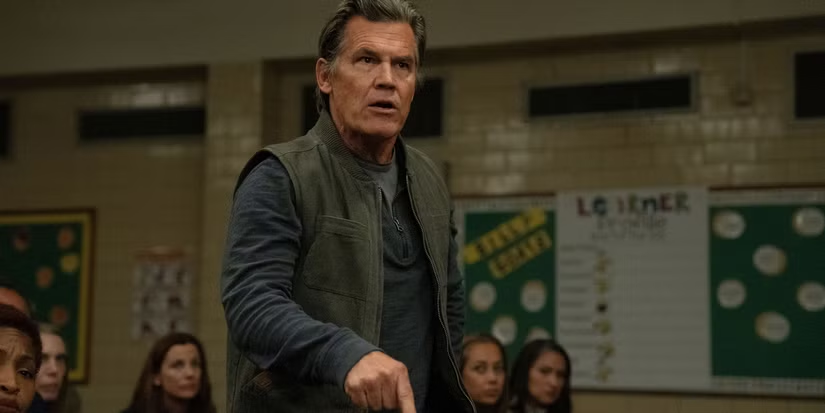
Horror is booming. The entire genre has become a licence to print money and shows no sign of slowing down. That’s not to say every film has been a success, but the general rule of low costs and easy returns has made it most profitable. Horror and Anime are the only safe bets these days, with every other genre struggling to break even. Given that, it’s no surprise to see a trend of the odd horror movie getting a huge boost from hype and word of mouth. Last year it was “The Substance” that got the hype, this year it is “Weapons”. This is a movie from writer/director Zach Cregger (Whose previous movie “Barbarian” also landed on the hype wagon). It features an ensemble cast but primarily Josh Brolin and Julia Garner. Larkin Seiple provides cinematography and music is by the collaboration between Cregger and the “Holladay Brothers”.
One night, in the town of Maybrook, Pennsylvania, seventeen children from elementary school teacher “Justine Gandy”‘s (Garner) third-grade class suddenly ran from their homes at 2:17 a.m. and disappeared. Only one student, “Alex Lilly” (Cary Christopher), remained. The story picks up two years later and follows the lives of various characters impacted by this event as they try and move on with their lives and get to the bottom of what happened. Specifically Justine, parent “Archer” (Brolin), Police Officer “Paul” (Alden Ehrenreich), junkie “James” (Austin Abrams) and the surviving child Alex. But to figure it out they must get over their own mistrust of each other first.

Narrative Technique
There are several movies that tell a story from multiple characters perspective. It’s one of a few techniques that allow the writers to hide important information from the viewer while still constructing a compelling narrative. The other main way of doing this is by telling the story out of order (Such as in “Memento” or “Strange Darlings”). The advantage with giving character perspectives is that you can change events based on how a human remembers them, adding in the “Unreliable narrator”. Weapon’s doesn’t really do this. Instead, it’s more like the time jump technique but without a set protagonist. In that regard it’s more comparable to “Strange Darlings” than a film like “Rashomon”.
The technique does had it’s advantages here. Effectively how it works is to give you a little more both at the start and end of the story with each new character. Our final character provides us with both the start and end of the story. There are a few horrors that recontextualize the timeline with it’s conclusion. There’s several that hold off from showing the true beginning of the story until the end. But I can’t think of any that progresses it in quite the same way. So point for originality there. The structure keeps the mystery alive far longer that a straight forward narrative could (Even if it held back the true beginning).

Unravelling The Mystery
The movie gives a very good atmosphere throughout. While I’m avoiding spoilers, so won’t reveal the nature of the evil in this story, I will say that I approve. It’s rare that this particular horror archetype is actually scary. A bit like vampires being made into sexy/romantic characters, this archetype is usually portrayed as heroic, misunderstood, sexy or an allegory for… Well that would give it away. So I appreciate that. Perhaps not as much as I appreciated Nosferatu and Last Voyage of the Demeter making Vampires scary again, but I do approve. This is a fairly long horror and the pacing is steady. Definite slow burn, but not one that will have you checking your watch.
Where I have some issues with the story is that it requires a seriously incompetent police investigation to work. Really almost anyone in that town not doing even the vaguest bit of investigation would have figured it out. Of course that is basically what did happen, but only after two entire years of it not crossing anyone’s mind to plot likely paths of the children for intersections. The evil plan was ultimately never going to work We’re also seeing a power level that is so off the charts that it draws into question the need for such a crazy plan. There’s a lot here that falls apart if you think about it too much.

Conclusion
Overall, this is a very impressive horror movie. If you remember my “Wolf Man” (2025) review earlier in the year you may remember that Julia Garner was the lead of that movie as well. So she gets the “Skarsgård” award for being in both the strongest and weakest horror film of the year. If you don’t get the reference, Bill Skarsgård was in both the abysmal “Crow” remake last year and the magnificent “Nosferatu”. So this is becoming a bit of a redemption arc trend. Anyway, Garner wasn’t the problem with “Wolf Man” and she’s actually very good here. The whole cast is pretty solid to be fair.
Ultimately this is a film that gives a great first experience in watching. It has definite flaws (Such as incompetent police and FBI investigations) and I am not sure it will maintain my appreciation through too many re-watches. But it’s one of the most original horror films I’ve seen for years and is well deserving of a strong 7/10. Highly recommended.





You must be logged in to post a comment.